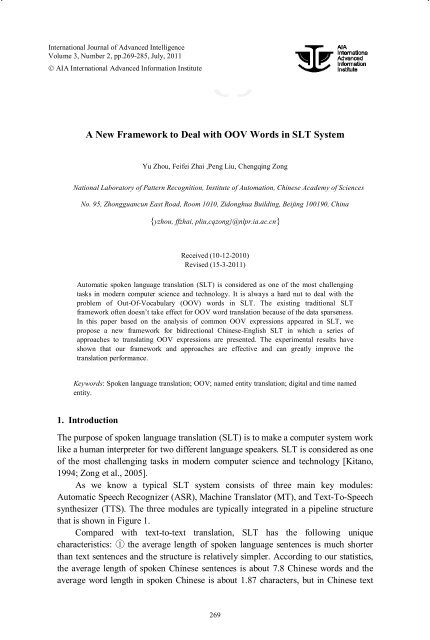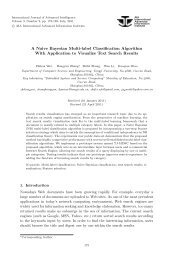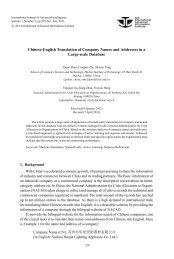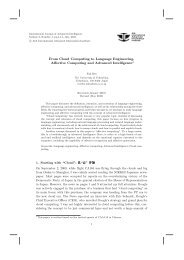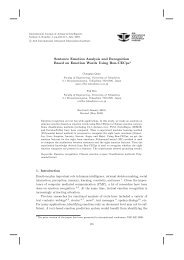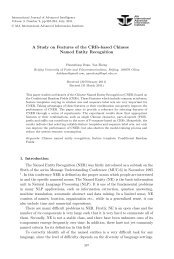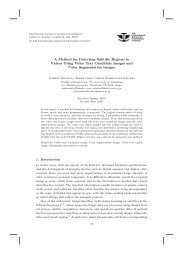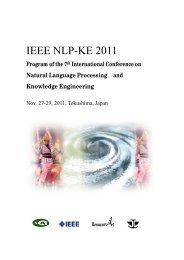A New Framework to Deal with OOV Words in SLT System
A New Framework to Deal with OOV Words in SLT System
A New Framework to Deal with OOV Words in SLT System
Create successful ePaper yourself
Turn your PDF publications into a flip-book with our unique Google optimized e-Paper software.
International Journal of Advanced Intelligence<br />
Volume 3, Number 2, pp.269-285, July, 2011<br />
AIA International Advanced Information Institute<br />
A <strong>New</strong> <strong>Framework</strong> <strong>to</strong> <strong>Deal</strong> <strong>with</strong> <strong>OOV</strong> <strong>Words</strong> <strong>in</strong> <strong>SLT</strong> <strong>System</strong><br />
Yu Zhou, Feifei Zhai ,Peng Liu, Chengq<strong>in</strong>g Zong<br />
National Labora<strong>to</strong>ry of Pattern Recognition, Institute of Au<strong>to</strong>mation, Ch<strong>in</strong>ese Academy of Sciences<br />
No. 95, Zhongguancun East Road, Room 1010, Zidonghua Build<strong>in</strong>g, Beij<strong>in</strong>g 100190, Ch<strong>in</strong>a<br />
{yzhou, ffzhai, pliu,cqzong}@nlpr.ia.ac.cn}<br />
Received (10-12-2010)<br />
Revised (15-3-2011)<br />
Au<strong>to</strong>matic spoken language translation (<strong>SLT</strong>) is considered as one of the most challeng<strong>in</strong>g<br />
tasks <strong>in</strong> modern computer science and technology. It is always a hard nut <strong>to</strong> deal <strong>with</strong> the<br />
problem of Out-Of-Vocabulary (<strong>OOV</strong>) words <strong>in</strong> <strong>SLT</strong>. The exist<strong>in</strong>g traditional <strong>SLT</strong><br />
framework often doesn’t take effect for <strong>OOV</strong> word translation because of the data sparseness.<br />
In this paper based on the analysis of common <strong>OOV</strong> expressions appeared <strong>in</strong> <strong>SLT</strong>, we<br />
propose a new framework for bidirectional Ch<strong>in</strong>ese-English <strong>SLT</strong> <strong>in</strong> which a series of<br />
approaches <strong>to</strong> translat<strong>in</strong>g <strong>OOV</strong> expressions are presented. The experimental results have<br />
shown that our framework and approaches are effective and can greatly improve the<br />
translation performance.<br />
Keywords: Spoken language translation; <strong>OOV</strong>; named entity translation; digital and time named<br />
entity.<br />
1. Introduction<br />
The purpose of spoken language translation (<strong>SLT</strong>) is <strong>to</strong> make a computer system work<br />
like a human <strong>in</strong>terpreter for two different language speakers. <strong>SLT</strong> is considered as one<br />
of the most challeng<strong>in</strong>g tasks <strong>in</strong> modern computer science and technology [Kitano,<br />
1994; Zong et al., 2005].<br />
As we know a typical <strong>SLT</strong> system consists of three ma<strong>in</strong> key modules:<br />
Au<strong>to</strong>matic Speech Recognizer (ASR), Mach<strong>in</strong>e Transla<strong>to</strong>r (MT), and Text-To-Speech<br />
synthesizer (TTS). The three modules are typically <strong>in</strong>tegrated <strong>in</strong> a pipel<strong>in</strong>e structure<br />
that is shown <strong>in</strong> Figure 1.<br />
Compared <strong>with</strong> text-<strong>to</strong>-text translation, <strong>SLT</strong> has the follow<strong>in</strong>g unique<br />
characteristics: 1 the average length of spoken language sentences is much shorter<br />
than text sentences and the structure is relatively simpler. Accord<strong>in</strong>g <strong>to</strong> our statistics,<br />
the average length of spoken Ch<strong>in</strong>ese sentences is about 7.8 Ch<strong>in</strong>ese words and the<br />
average word length <strong>in</strong> spoken Ch<strong>in</strong>ese is about 1.87 characters, but <strong>in</strong> Ch<strong>in</strong>ese text<br />
269
270 Yu Zhou, Feifei Zhai<br />
the average length of sentences is about 22 Ch<strong>in</strong>ese words and each word conta<strong>in</strong>s<br />
about 2.5 Ch<strong>in</strong>ese characters <strong>in</strong> average [Zong et al., 1999].<br />
source audio signal<br />
source text<br />
Au<strong>to</strong>matic Speech Recognition<br />
(ASR)<br />
Text-To-Speech<br />
(TTS)<br />
Mach<strong>in</strong>e<br />
Translation<br />
(MT)<br />
target speech<br />
target text<br />
Fig. 1. A Typical Architecture of <strong>SLT</strong> <strong>System</strong><br />
It is quite different; 2 there are so many ill-formed expressions <strong>in</strong> spoken language<br />
utterances, <strong>in</strong>clud<strong>in</strong>g redundancy, repetition, repair, word order confusion, ellipsis,<br />
and so on. Accord<strong>in</strong>g <strong>to</strong> our statistics, <strong>in</strong> spoken Ch<strong>in</strong>ese language, about 4.70%<br />
sentences conta<strong>in</strong> redundancy, 3.56% sentences have repetition, 32.61% sentences are<br />
<strong>in</strong>complete, and 44.59% sentences are only of one word [Zong et al., 1999]; 3 In<br />
Ch<strong>in</strong>ese-<strong>to</strong>-English translation, a large number of homonyms <strong>in</strong> Ch<strong>in</strong>ese characters or<br />
Ch<strong>in</strong>ese words make it impossible <strong>to</strong> have a very satisfac<strong>to</strong>ry recognition results.<br />
Therefore, it is a very challeng<strong>in</strong>g task <strong>to</strong> correctly translate the results <strong>with</strong> noise<br />
from ASR; 4 a practical <strong>SLT</strong> system needs real time response speed. However, it is<br />
difficult <strong>to</strong> have a high speed <strong>in</strong> such an <strong>in</strong>tegrated system <strong>with</strong> several modules.<br />
In recent years, advances <strong>in</strong> ASR, MT, and TTS technologies have paved the way<br />
for the emergence of various <strong>SLT</strong> systems and ensured the basic performance and<br />
robustness. However, though <strong>SLT</strong> research and development have made significant<br />
progresses over the decades, there still exist a number of theoretical and technical<br />
problems and still has much room <strong>to</strong> improve the system performance.<br />
This paper presents a new approach <strong>to</strong> deal<strong>in</strong>g <strong>with</strong> the problem of <strong>OOV</strong> words<br />
<strong>in</strong> Ch<strong>in</strong>ese-<strong>to</strong>-English <strong>SLT</strong>. The rema<strong>in</strong>der of the paper is organized as follows:<br />
Section 2 gives our <strong>in</strong>vestigation of <strong>OOV</strong> words <strong>in</strong> Ch<strong>in</strong>ese-<strong>to</strong>-English <strong>SLT</strong>; Section<br />
3 <strong>in</strong>troduces the related work and Section 4 gives our framework by <strong>in</strong>troduc<strong>in</strong>g our<br />
approach <strong>to</strong> deal<strong>in</strong>g <strong>with</strong> <strong>OOV</strong> <strong>in</strong> bidirectional Ch<strong>in</strong>ese-English <strong>SLT</strong>; Section 5 gives<br />
the details on implementation of our approaches; The experimental results are shown<br />
<strong>in</strong> Section 6. And f<strong>in</strong>ally, the conclud<strong>in</strong>g remarks are given <strong>in</strong> Section 7.
A new <strong>Framework</strong> <strong>to</strong> <strong>Deal</strong> <strong>with</strong> <strong>OOV</strong> <strong>Words</strong> <strong>in</strong> <strong>SLT</strong> <strong>System</strong> 271<br />
2. Investigation of <strong>OOV</strong> <strong>Words</strong> <strong>in</strong> <strong>SLT</strong><br />
Due <strong>to</strong> the characteristics of spoken language, there are always numbers of <strong>OOV</strong><br />
words <strong>in</strong> <strong>SLT</strong>. Accord<strong>in</strong>g <strong>to</strong> our <strong>in</strong>vestigation, the <strong>OOV</strong> words <strong>in</strong> Ch<strong>in</strong>ese-English<br />
translation eng<strong>in</strong>e us<strong>in</strong>g statistical mach<strong>in</strong>e translation (SMT) models are ma<strong>in</strong>ly<br />
caused by the follow<strong>in</strong>g reasons: a) The limited size of tra<strong>in</strong><strong>in</strong>g data: the tra<strong>in</strong><strong>in</strong>g data<br />
is always <strong>in</strong>sufficient and the sparseness is always a serious problem <strong>in</strong> SMT; b) For<br />
Ch<strong>in</strong>ese-<strong>to</strong>-English <strong>SLT</strong>, due <strong>to</strong> the problem of homonyms <strong>in</strong> Ch<strong>in</strong>ese, it is a common<br />
type of ASR errors that a Ch<strong>in</strong>ese word or a character is wrongly substituted by its<br />
homonyms. And also, different speaker <strong>with</strong> different accent or pronunciation style,<br />
the errors are quite different. For example, if a Ch<strong>in</strong>ese speaker <strong>with</strong> southern accent<br />
<strong>in</strong> ma<strong>in</strong>land of Ch<strong>in</strong>a utters the follow<strong>in</strong>g sentence “ 冰 冻 三 尺 , 非 一 日 之 寒 。(the<br />
Ch<strong>in</strong>ese P<strong>in</strong>y<strong>in</strong> is: b<strong>in</strong>g dong san chi, fei yi ri zhi han)”(Rome was not built <strong>in</strong> a day.),<br />
the ASR result is probably “ 冰 冻 三 次 , 非 一 日 自 汗 ”, <strong>in</strong> which the Ch<strong>in</strong>ese words<br />
underl<strong>in</strong>ed are wrongly given because they have the similar pronunciation <strong>with</strong> their<br />
orig<strong>in</strong>al words “ 三 尺 ” and “ 之 寒 ” respectively; c) There are often some new words <strong>in</strong><br />
a new area. Even if <strong>in</strong> the same area, there will be new words <strong>with</strong> the change of time.<br />
For example, “ 给 力 (feed force), 奥 特 (out of date/out of fashion)” are all new words<br />
<strong>in</strong> spoken Ch<strong>in</strong>ese <strong>in</strong> recent years. Therefore, it is impossible <strong>to</strong> make the tra<strong>in</strong><strong>in</strong>g<br />
corpus and the extracted translation rules cover all of the language phenomena and<br />
lexical <strong>in</strong>formation.<br />
We have analyzed 461 <strong>OOV</strong> words <strong>in</strong> 2,652 Ch<strong>in</strong>ese ASR output sentences. The<br />
Table 1. Statistics on <strong>OOV</strong> <strong>Words</strong> <strong>in</strong> ASR Output<br />
<strong>OOV</strong> Types Number Ratio (%)<br />
Personal names 178 38.61<br />
Place names 39 8.46<br />
Organization names 22 4.77<br />
Digits 69 14.97<br />
Date&Time 10 2.17<br />
Foreign language words 73 15.84<br />
Others 70 15.18<br />
Total 461 100.00<br />
types of <strong>OOV</strong> words are shown <strong>in</strong> Table 1.<br />
Hav<strong>in</strong>g further <strong>in</strong>vestigated the 461 <strong>OOV</strong> words, we found that most of the <strong>OOV</strong><br />
words are caused by the wrong word boundaries. And the wrong word boundaries are<br />
caused by the wrong syllable segmentation. Table 2 gives the statistical results on<br />
distribution of <strong>in</strong>correct boundaries.
272 Yu Zhou, Feifei Zhai<br />
Table 2. Statistics on Incorrect Boundaries of <strong>OOV</strong> <strong>Words</strong><br />
<strong>OOV</strong> Type Number Boundary Error Ratio(%)<br />
Personal names 178 14 7.87%<br />
Place names 39 4 10.26%<br />
Organization names 22 11 50.00%<br />
Digits 69 2 2.90%<br />
Time&Date 10 5 50.00%<br />
Others 70 9 12.86%<br />
Total 388 45 -<br />
From the statistical results <strong>in</strong> Table 1 and Table 2, we can clearly see that the<br />
<strong>OOV</strong> words are widespread <strong>in</strong> ASR outputs. As shown <strong>in</strong> Table 1 and Table 2, the<br />
<strong>OOV</strong> problem is ma<strong>in</strong>ly caused by the follow<strong>in</strong>g reasons: (1) Named entities (NE)<br />
<strong>in</strong>clud<strong>in</strong>g the personal names, place names and organization names, which we call<br />
such <strong>OOV</strong> as <strong>OOV</strong>-1; (2) Digits, date and time <strong>OOV</strong>s, we call such <strong>OOV</strong> expressions<br />
as <strong>OOV</strong>-2; (3) Homophone words which ma<strong>in</strong>ly generated by the wrong ASR output,<br />
we call such <strong>OOV</strong> words as <strong>OOV</strong>-3; (4) Other <strong>OOV</strong> words, which are signed as<br />
<strong>OOV</strong>-4; and (5) Foreign language words, which are named as <strong>OOV</strong>-5.<br />
3. Related Work<br />
Many approaches have been proposed <strong>to</strong> solve the problem of <strong>OOV</strong> words, <strong>in</strong> which<br />
the <strong>in</strong>teractive translation approach is more popular. The research on <strong>in</strong>teractive<br />
translation has been carried out for many years s<strong>in</strong>ce [Kay et al., 1973] first<br />
implemented the <strong>in</strong>teractive translation system MIND, such as [Waibel, 1996;<br />
Seligman, 1997; Zong et al., 2002, 2005] and so on. Accord<strong>in</strong>g <strong>to</strong> the different stages<br />
of <strong>in</strong>teraction that user is <strong>in</strong>volved <strong>in</strong>, we divide the <strong>in</strong>teractive approaches <strong>in</strong><strong>to</strong> three<br />
types as follows: 1 Interaction before translation (IBT). The basic pr<strong>in</strong>ciple of IBT is<br />
<strong>to</strong> correct the wrong or ambiguous recognition output of ASR before translation and<br />
make the MT <strong>in</strong>put correct and unambiguous. Generally, the tasks of IBT method<br />
<strong>in</strong>clude <strong>to</strong> format source text, segment source sentences, correct the recognition errors,<br />
process the special symbols, and so on [Waibel, 1996; Seligman, 1997]. 2<br />
Interaction dur<strong>in</strong>g translation (IDT). IDT method carries out <strong>in</strong>teraction <strong>in</strong> translation<br />
process and generates candidate translations [Lane et al., 2008; Zong et al., 2002,<br />
2005]. and 3 Interaction after translation (IAT). IAT method is the simplest one. Its<br />
ma<strong>in</strong> objective is <strong>to</strong> provide users <strong>with</strong> a friendly <strong>in</strong>terface <strong>to</strong> let users choose proper<br />
translation results from candidates or correct the translation errors <strong>with</strong>out much<br />
effort. The users <strong>to</strong> use this method have <strong>to</strong> know both the source language and target
A new <strong>Framework</strong> <strong>to</strong> <strong>Deal</strong> <strong>with</strong> <strong>OOV</strong> <strong>Words</strong> <strong>in</strong> <strong>SLT</strong> <strong>System</strong> 273<br />
language. The representative systems are SYSTRAN * and HICATS/JE [Kaji, 1987].<br />
Three girls <strong>in</strong> Figure 2 stand for the different <strong>in</strong>teraction methods <strong>in</strong> <strong>SLT</strong> process<br />
respectively.<br />
IBT IDT IAT<br />
Source Input<br />
Mach<strong>in</strong>e<br />
Translation<br />
<strong>System</strong><br />
Target Output<br />
Correct<br />
Output<br />
Fig. 2. The Three Interaction Types<br />
In some approaches the additional language resources are employed <strong>to</strong> solve the<br />
<strong>OOV</strong> problem. [Zhou et al., 2007] proposed an approach <strong>to</strong> <strong>in</strong>terpret<strong>in</strong>g the semantic<br />
mean<strong>in</strong>gs of <strong>OOV</strong> words by us<strong>in</strong>g the synonyms knowledge <strong>in</strong> the source language.<br />
This method is only effective <strong>to</strong> alleviate those <strong>OOV</strong> words that have the synonyms<br />
<strong>with</strong> the same Part-Of-Speech (POS). If the synonyms have different POSs, the<br />
translation eng<strong>in</strong>e may get wrong translation results.<br />
[Habash, 2008] proposed the follow<strong>in</strong>g four methods <strong>to</strong> deal <strong>with</strong> the problem of<br />
<strong>OOV</strong> words: (a) Spell<strong>in</strong>g expansion; (b) Morphological expansion; (c) Dictionary<br />
term expansion; and (d) Proper name transliteration. However, most of the methods<br />
are not suitable for bidirectional Ch<strong>in</strong>ese-English translation system for Ch<strong>in</strong>ese is not<br />
an adhesive language <strong>with</strong>out <strong>in</strong>flection.<br />
[Mirk<strong>in</strong> et al., 2009] proposed a method <strong>to</strong> use WordNet <strong>to</strong> solve the problem of<br />
<strong>OOV</strong> words. [Aziz et al., 2010] proposed an approach <strong>to</strong> tak<strong>in</strong>g <strong>in</strong><strong>to</strong> account of both<br />
paraphrased and entailed words and used a context model score.<br />
All of these related work mentioned above have their own merits. This br<strong>in</strong>gs up<br />
the question: how <strong>to</strong> make good use of the merits of exist<strong>in</strong>g approaches <strong>to</strong> improve<br />
the performance of a Ch<strong>in</strong>ese-English <strong>SLT</strong> system As we mentioned above, IBT<br />
method and IAT method are aimed <strong>to</strong> process<strong>in</strong>g the <strong>in</strong>put and output of translation<br />
module respectively. They are not <strong>in</strong>volved <strong>in</strong> the process of mach<strong>in</strong>e translation. As<br />
we said before, even if an <strong>in</strong>put is completely correct, the MT eng<strong>in</strong>e probably still<br />
can’t translate it due <strong>to</strong> the ill-formed expressions or other problems [Zong et al.,<br />
2005]. IDT method works <strong>in</strong> MT process, but it never pre-processes the <strong>in</strong>put even if<br />
an <strong>in</strong>put is completely wrong or not understandable. So we propose a new framework<br />
* http://www.systransoft.com/
274 Yu Zhou, Feifei Zhai<br />
<strong>to</strong> solve the problem of <strong>OOV</strong> words by comb<strong>in</strong>g the three <strong>in</strong>teraction methods, which<br />
makes full use of the merits of the three <strong>in</strong>teraction methods.<br />
4. Our <strong>Framework</strong><br />
Our frameworks <strong>to</strong> deal <strong>with</strong> the problems of <strong>OOV</strong> words for Ch<strong>in</strong>ese-<strong>to</strong>-English<br />
(C2E) translation and English-<strong>to</strong>-Ch<strong>in</strong>ese (E2C) translation are respectively shown <strong>in</strong><br />
Figure 3 and Figure 4. From the figures we can see that our approaches <strong>to</strong> deal<strong>in</strong>g<br />
<strong>with</strong> <strong>OOV</strong> problem are different from the exist<strong>in</strong>g <strong>SLT</strong> framework shown <strong>in</strong> Figure 1.<br />
In Figure 3, <strong>in</strong> each stage there are three types of output (word-based, character-based,<br />
and P<strong>in</strong>y<strong>in</strong>-based) which can greatly alleviate the <strong>OOV</strong>s. In the f<strong>in</strong>al stage, a<br />
comb<strong>in</strong>ation modular is employed <strong>to</strong> f<strong>in</strong>d an optimal translation as output given <strong>to</strong><br />
TTS modular.<br />
Based on the frameworks given <strong>in</strong> Figure 3 and Figure 4, the <strong>SLT</strong> systems work<br />
as the follow<strong>in</strong>g procedure:<br />
(i) A source speech is recognized <strong>in</strong><strong>to</strong> the source text by an ASR;<br />
(ii) All NEs <strong>in</strong> source text are identified and translated first, then the orig<strong>in</strong>al NEs<br />
are replaced <strong>with</strong> their correspond<strong>in</strong>g translations (target NEs);<br />
(iii) The digits, date and time expressions <strong>in</strong> source language are translated <strong>in</strong><strong>to</strong><br />
target ones by D&T recognition and translation module;<br />
(iv) The new generated source text is translated <strong>in</strong><strong>to</strong> target text by MT module after<br />
step (2) and (3);<br />
(v) There may still exist some <strong>OOV</strong> words <strong>with</strong>out translation, they will be<br />
replaced by us<strong>in</strong>g common bil<strong>in</strong>gual translation dictionaries;<br />
(vi) F<strong>in</strong>ally, the target text is converted <strong>in</strong><strong>to</strong> speech by TTS module.<br />
In order <strong>to</strong> recognize and translate the <strong>OOV</strong>-1, <strong>OOV</strong>-2 and <strong>OOV</strong>-4 more<br />
accurately, we simultaneously <strong>in</strong>troduce three modes (word-based, character-based<br />
and P<strong>in</strong>y<strong>in</strong>-based) <strong>in</strong> IBT/IAT stages on CE <strong>SLT</strong> system. How can the three modes<br />
alleviate the <strong>OOV</strong> problems effectively It will be fully reflected <strong>in</strong> the later<br />
translation and comb<strong>in</strong>ation model, shown <strong>in</strong> Section 5. In IDT stage, we propose a<br />
new translation model <strong>to</strong> alleviate the <strong>OOV</strong> problems and such model is especially<br />
very effective for the <strong>OOV</strong>-3. The new translation model is built based on three word<br />
alignments, which are word-based, P<strong>in</strong>y<strong>in</strong>-based, and character-based respectively.<br />
And it will play a more important role by <strong>in</strong>troduc<strong>in</strong>g a comb<strong>in</strong>ation model <strong>in</strong> IAT<br />
stage. The comb<strong>in</strong>ation model is imperative <strong>to</strong> generate an optimal translation result<br />
based on the candidate translations from different translation eng<strong>in</strong>es. In Section 5,<br />
we will focus on C2E translation <strong>to</strong> give more details. In summary, our approaches <strong>to</strong><br />
deal<strong>in</strong>g <strong>with</strong> the different types of <strong>OOV</strong> words are given <strong>in</strong> detail as follows:<br />
<strong>OOV</strong>-1 Process<strong>in</strong>g: In <strong>SLT</strong> system, especially <strong>in</strong> text-<strong>to</strong>-text SMT system, NEs<br />
recognition and translation are usually processed by an <strong>in</strong>dividual module us<strong>in</strong>g some<br />
special approaches, e.g., the work proposed by [Chen et al., 2008]. But if we
A new <strong>Framework</strong> <strong>to</strong> <strong>Deal</strong> <strong>with</strong> <strong>OOV</strong> <strong>Words</strong> <strong>in</strong> <strong>SLT</strong> <strong>System</strong> 275<br />
<strong>in</strong>troduce such method <strong>in</strong> <strong>SLT</strong> system and translate each NE depend<strong>in</strong>g on the method,<br />
it will heavily <strong>in</strong>crease the complexity of the overall system and reduce the whole<br />
translation speed. Even when we <strong>in</strong>troduce a NE recognition and translation module,<br />
such problem still exists. So here we <strong>in</strong>troduce the IBT idea <strong>to</strong> au<strong>to</strong>matically<br />
recognize and translation the NEs of ASR output <strong>in</strong> advance. Our method works <strong>in</strong><br />
the follow<strong>in</strong>g two steps: 1) We only translate the source NEs <strong>with</strong> a<br />
maximum-match<strong>in</strong>g algorithm <strong>with</strong> support of a bil<strong>in</strong>gual NE database. Here the<br />
bil<strong>in</strong>gual NE database also provides three types <strong>in</strong>formation. The three types are<br />
word-based, character-based and P<strong>in</strong>y<strong>in</strong>-based. 2) We use the method proposed by<br />
[Chen et al., 2008] <strong>to</strong> translate the complex NEs, for example, the organization<br />
names.<br />
Word-based<br />
Translation Dictionary<br />
Character-based<br />
Translation Dictionary<br />
C2E<br />
NE<br />
Database<br />
P<strong>in</strong>y<strong>in</strong>-based<br />
Translation Dictionary<br />
Source Audio Signal<br />
Word-based<br />
ASR Output<br />
Word-based Output<br />
<strong>with</strong> NER Translation<br />
ASR Module<br />
Character-based<br />
ASR Output<br />
Maximum-match<strong>in</strong>g<br />
Module<br />
Character-based<br />
Output <strong>with</strong> NER<br />
Translation<br />
P<strong>in</strong>y<strong>in</strong>-based<br />
ASR Output<br />
IBT<br />
P<strong>in</strong>y<strong>in</strong>-based Output<br />
<strong>with</strong> NER Translation<br />
Word-based<br />
MT output <strong>with</strong> <strong>OOV</strong>-4<br />
Word-based Output <strong>with</strong><br />
NER, Digits, Date&Time<br />
Translation<br />
Character-based<br />
MT output <strong>with</strong> <strong>OOV</strong>-4<br />
MT<br />
Module<br />
Character-based Output <strong>with</strong><br />
NER, Digits, Date&Time<br />
Translation<br />
D&T Recognition&<br />
Translation Module<br />
P<strong>in</strong>y<strong>in</strong>-based<br />
MT output <strong>with</strong> <strong>OOV</strong>-4<br />
IDT<br />
P<strong>in</strong>y<strong>in</strong>-based Output <strong>with</strong><br />
NER, Digits, Date&Time<br />
Translation<br />
Recognition<br />
&<br />
Translation<br />
Rules<br />
C2E<br />
Digits,<br />
Date<br />
&Time<br />
Database<br />
IAT<br />
Fianl Word-based Output<br />
F<strong>in</strong>al Character-based<br />
Output<br />
<strong>System</strong> comb<strong>in</strong>ation<br />
module<br />
F<strong>in</strong>al output<br />
translation<br />
TTS<br />
Module<br />
Common Word &Character&<br />
P<strong>in</strong>y<strong>in</strong> Translation Dictionary<br />
F<strong>in</strong>al P<strong>in</strong>y<strong>in</strong>-based Output<br />
Target Voice Speech<br />
Fig. 3. Our <strong>Framework</strong> <strong>to</strong> <strong>Deal</strong> <strong>with</strong> <strong>OOV</strong> <strong>Words</strong> <strong>in</strong> C2E <strong>SLT</strong> <strong>System</strong><br />
<strong>OOV</strong>-2 Process<strong>in</strong>g: For digits, date and time <strong>OOV</strong> expression recognition and<br />
translation, we have developed a special <strong>to</strong>ol named as D&T module [Zhai et al.,<br />
2009]. Zhai et al. (2009) carefully <strong>in</strong>vestigated the structural characteristics of time<br />
and number named entities <strong>in</strong> both Ch<strong>in</strong>ese and English and classified them <strong>in</strong><strong>to</strong>
276 Yu Zhou, Feifei Zhai<br />
several k<strong>in</strong>ds. They have developed a rule-based analyzer <strong>to</strong> recognize and translate<br />
all digits, date and time expressions from Ch<strong>in</strong>ese <strong>to</strong> English and English <strong>to</strong> Ch<strong>in</strong>ese.<br />
Source Audio Signal<br />
NE<br />
translation dictionary<br />
E2C<br />
NE<br />
Database<br />
IBT<br />
ASR Module<br />
ASR Output<br />
Maximum- match<strong>in</strong>g<br />
Module<br />
ASR Output <strong>with</strong><br />
NE Translation<br />
Output Translation<br />
<strong>with</strong> <strong>OOV</strong>-4<br />
Common Word<br />
Translation<br />
Dictionary<br />
IDT<br />
MT<br />
Module<br />
ASR<br />
Output<br />
<strong>with</strong> NE,<br />
Digits,<br />
Date& Time<br />
Translation<br />
D& T Recognition&<br />
Translation Module<br />
Recognition<br />
&<br />
Translation<br />
Rules<br />
E2C<br />
Digits,<br />
Date&<br />
Time<br />
Database<br />
IAT<br />
F<strong>in</strong>al output<br />
translation<br />
TTS<br />
Module<br />
Target Voice Speech<br />
Fig. 4. Our <strong>Framework</strong> <strong>to</strong> <strong>Deal</strong> <strong>with</strong> <strong>OOV</strong>s <strong>in</strong> E2C <strong>SLT</strong> <strong>System</strong><br />
<strong>OOV</strong>-3 Process<strong>in</strong>g: This type of <strong>OOV</strong> words is processed by an additional<br />
module us<strong>in</strong>g P<strong>in</strong>y<strong>in</strong>-based module <strong>to</strong> alleviate such problem. See Section 5.<br />
<strong>OOV</strong>-4 Process<strong>in</strong>g: This type of <strong>OOV</strong> words is processed by us<strong>in</strong>g a common<br />
bil<strong>in</strong>gual dictionary.<br />
<strong>OOV</strong>-5 Process<strong>in</strong>g: This type of <strong>OOV</strong> words is directly output as the f<strong>in</strong>al<br />
translations.<br />
5. Implementation of Our Approaches<br />
To implement a complete MT system, the key techniques ma<strong>in</strong>ly <strong>in</strong>clude two issues:<br />
one is <strong>to</strong> extract the translation knowledge (<strong>in</strong>clud<strong>in</strong>g the translation rules and<br />
re-order<strong>in</strong>g rules) <strong>in</strong> tra<strong>in</strong><strong>in</strong>g process and the other one is <strong>to</strong> develop an effective<br />
decod<strong>in</strong>g algorithm <strong>in</strong> decod<strong>in</strong>g process. At present, the rule-based method and<br />
statistical method are two basic methods and the statistical method has become the<br />
ma<strong>in</strong>stream <strong>in</strong> recent years. In statistical method there are word-based, phrase-based,
A new <strong>Framework</strong> <strong>to</strong> <strong>Deal</strong> <strong>with</strong> <strong>OOV</strong> <strong>Words</strong> <strong>in</strong> <strong>SLT</strong> <strong>System</strong> 277<br />
and syntax-based translation models as well. The common nature of these models is<br />
<strong>to</strong> extract more complete and accurate translation knowledge from tra<strong>in</strong><strong>in</strong>g data so as<br />
<strong>to</strong> guide the decoder <strong>to</strong> get the better translation results. Now the decod<strong>in</strong>g algorithms<br />
ma<strong>in</strong>ly use certa<strong>in</strong> search strategy, which guides the decoder <strong>to</strong> f<strong>in</strong>d an optimal path<br />
<strong>to</strong> obta<strong>in</strong> the f<strong>in</strong>al translation results <strong>with</strong> the guidance of pre-extracted translation<br />
knowledge. Consider<strong>in</strong>g the different translation eng<strong>in</strong>es are probably based on<br />
different translation models and get different translation results, some comb<strong>in</strong>ation<br />
approaches have been proposed <strong>to</strong> emerge the translation results from different<br />
translation eng<strong>in</strong>es <strong>to</strong> generate the better translation result as f<strong>in</strong>al output. The process<br />
of system comb<strong>in</strong>ation is called as comb<strong>in</strong><strong>in</strong>g process hereafter.<br />
Now we give the correspond<strong>in</strong>g framework of the three ma<strong>in</strong> technologies<br />
embodied <strong>in</strong> the processes of tra<strong>in</strong><strong>in</strong>g, decod<strong>in</strong>g and comb<strong>in</strong><strong>in</strong>g, which are shown <strong>in</strong><br />
Figure 5 a), b) and c) respectively. The operat<strong>in</strong>g steps of each process will be<br />
described separately. The shadow modules <strong>in</strong> these figures are the highlighted objects<br />
which are modified by our proposed methods. These methods will be described later<br />
<strong>in</strong> detail.<br />
The bil<strong>in</strong>gual<br />
tra<strong>in</strong><strong>in</strong>g corpus<br />
Preprocess<strong>in</strong>g<br />
The preprocessed<br />
bil<strong>in</strong>gual corpus<br />
Word alignment<br />
source test<br />
sentence<br />
Preprocess<strong>in</strong>g<br />
The preprocessed<br />
bil<strong>in</strong>gual corpus<br />
Decod<strong>in</strong>g model<br />
The <strong>in</strong>put source sentence<br />
MT eng<strong>in</strong>e 1 ……… MT eng<strong>in</strong>e n<br />
The collection of n * N-Best lists<br />
Alignment approach<br />
MBR<br />
Decod<strong>in</strong>g<br />
Alignment<br />
reference<br />
The bil<strong>in</strong>gul corpus <strong>with</strong><br />
word alignment <strong>in</strong>formation<br />
Translation<br />
model<strong>in</strong>g<br />
Translation<br />
model<br />
Translation result<br />
Post process<strong>in</strong>g<br />
Target<br />
sentence<br />
Consensus alignment<br />
Confusion network<br />
Target sentence<br />
Merg<strong>in</strong>g<br />
Confusion<br />
network<br />
decod<strong>in</strong>g<br />
Fig. 5. a). Tra<strong>in</strong><strong>in</strong>g process Figure 5 b). Decod<strong>in</strong>g process Figure 5 c). Comb<strong>in</strong><strong>in</strong>g process<br />
• Tra<strong>in</strong><strong>in</strong>g process<br />
As shown <strong>in</strong> Figure 5 a), the tra<strong>in</strong><strong>in</strong>g process works through the follow<strong>in</strong>g steps:<br />
(i) The bil<strong>in</strong>gual tra<strong>in</strong><strong>in</strong>g corpus is pre-processed <strong>in</strong>clud<strong>in</strong>g the Ch<strong>in</strong>ese word<br />
segmentation, English <strong>to</strong>kenization, and so forth;
278 Yu Zhou, Feifei Zhai<br />
(ii) The pre-processed bil<strong>in</strong>gual tra<strong>in</strong><strong>in</strong>g data are given <strong>to</strong> the word alignment model<br />
<strong>to</strong> obta<strong>in</strong> the word alignments;<br />
(iii) The bil<strong>in</strong>gual tra<strong>in</strong><strong>in</strong>g data <strong>with</strong> the word alignments <strong>in</strong>formation are passed <strong>to</strong><br />
the translation model <strong>to</strong> extract the translation knowledge as the translation<br />
model.<br />
(iv) The language model is generally obta<strong>in</strong>ed by the free <strong>to</strong>olkit (such as SRILM†)<br />
<strong>with</strong>out any modification.<br />
• Decod<strong>in</strong>g process<br />
As shown <strong>in</strong> Figure 5 b), the decod<strong>in</strong>g process works through the follow<strong>in</strong>g steps:<br />
(i) The test sentence is pre-processed <strong>in</strong>clud<strong>in</strong>g the Ch<strong>in</strong>ese word segmentation,<br />
English <strong>to</strong>kenization, and so forth;<br />
(ii) The pre-processed test sentences are sent <strong>to</strong> the decod<strong>in</strong>g model <strong>to</strong> obta<strong>in</strong> the<br />
translation result;<br />
(iii) The translation result is then post-processed <strong>to</strong> be f<strong>in</strong>al translation.<br />
• Comb<strong>in</strong><strong>in</strong>g process<br />
As shown <strong>in</strong> Figure 5 c), the comb<strong>in</strong><strong>in</strong>g process works through the follow<strong>in</strong>g steps:<br />
(i) Input sentence is pre-processed and passed <strong>in</strong><strong>to</strong> multiple MT eng<strong>in</strong>es (suppose n<br />
MT eng<strong>in</strong>es) <strong>to</strong> produce n*N-Best lists of translations separately from n MT<br />
eng<strong>in</strong>es;<br />
(ii) The alignment reference is obta<strong>in</strong>ed by the MBR Decod<strong>in</strong>g;<br />
(iii) The consensus alignment is built <strong>with</strong> the help of alignment approach and the<br />
alignment reference;<br />
(iv) The confusion network is built based on the consensus alignment;<br />
(v) The target sentence is generated by us<strong>in</strong>g the confusion network decod<strong>in</strong>g.<br />
Currently, there are few methods proposed <strong>to</strong> process the noisy results from ASR<br />
module. In order <strong>to</strong> better adapt <strong>to</strong> our framework, we have proposed efficient<br />
methods and solutions, which are highlighted <strong>with</strong> shadow shown <strong>in</strong> Figure 5. The<br />
modified methods are described as follows.<br />
5.1. Tra<strong>in</strong><strong>in</strong>g &Decod<strong>in</strong>g Process<br />
Traditionally, the orig<strong>in</strong>al bil<strong>in</strong>gual data are expressed <strong>in</strong> one type, such as<br />
word-based or character-based. In order <strong>to</strong> solve the <strong>OOV</strong>-3 problem effectively, we<br />
<strong>in</strong>troduce the type of P<strong>in</strong>y<strong>in</strong>-based <strong>in</strong>put. In order <strong>to</strong> obta<strong>in</strong> more accurate and<br />
complete translation knowledge, we pre-process the ASR output <strong>in</strong><strong>to</strong> three types,<br />
namely, word-based, character-based, and P<strong>in</strong>y<strong>in</strong>-based. This idea is shown <strong>in</strong> Figure<br />
6. In the follow<strong>in</strong>g, we will first expla<strong>in</strong> why we can improve the translation<br />
performance by <strong>in</strong>troduc<strong>in</strong>g the three types of translation models. Then we will<br />
expla<strong>in</strong> why we can solve <strong>OOV</strong>-3 problem <strong>with</strong> P<strong>in</strong>y<strong>in</strong>-based model.<br />
† http://www.speech.sri.com/projects/srilm/manpages/
A new <strong>Framework</strong> <strong>to</strong> <strong>Deal</strong> <strong>with</strong> <strong>OOV</strong> <strong>Words</strong> <strong>in</strong> <strong>SLT</strong> <strong>System</strong> 279<br />
Orig<strong>in</strong>al<br />
C-E<br />
Parallel<br />
Tra<strong>in</strong><strong>in</strong>g<br />
Corpus<br />
Word-based Parallel<br />
Tra<strong>in</strong><strong>in</strong>g Corpus<br />
Character-based Parallel<br />
Tra<strong>in</strong><strong>in</strong>g Corpus<br />
P<strong>in</strong>y<strong>in</strong>-based Parallel<br />
Tra<strong>in</strong><strong>in</strong>g Corpus<br />
Word-based Word Alignment<br />
Character-based<br />
Word Alignment<br />
P<strong>in</strong>y<strong>in</strong>-based<br />
Word Alignment<br />
Comb<strong>in</strong>e-<br />
Word-<br />
Alignment<br />
Word-based<br />
Translation Model<br />
Character-based<br />
Translation Model<br />
P<strong>in</strong>y<strong>in</strong>-based<br />
Translation Model<br />
Fig. 6. MT Module Based on Three Types of Inputs<br />
Based on our experience on MT development, a different word alignment can<br />
extract different translation knowledge and comb<strong>in</strong><strong>in</strong>g different word alignments will<br />
lead <strong>to</strong> achieve better translation knowledge. We here comb<strong>in</strong>e the character-based<br />
and P<strong>in</strong>y<strong>in</strong>-based word alignments for the character and the P<strong>in</strong>y<strong>in</strong> have the same<br />
positions <strong>in</strong> a sentence. As we all know, we can achieve a better translation result by<br />
comb<strong>in</strong><strong>in</strong>g more translation hypotheses. So here we use the three types of <strong>in</strong>put<br />
<strong>in</strong>stead of one <strong>to</strong> obta<strong>in</strong> the correspond<strong>in</strong>g three translation models and <strong>to</strong> generate<br />
more translation hypotheses.<br />
The current translation models are based on literal form (word-based or<br />
character-based model). They cannot recall the type of <strong>OOV</strong>-3 which is caused by<br />
ASR errors. Now we use an example <strong>to</strong> show why we can solve <strong>OOV</strong>-3 problem by<br />
<strong>in</strong>troduc<strong>in</strong>g P<strong>in</strong>y<strong>in</strong>-based translation model for C2E translation, see Figure 7.<br />
From the example <strong>in</strong> Figure 7, we can clearly see that it can also get correct<br />
translation results even <strong>with</strong> a wrong recognition output by ASR. The reasons are<br />
summarized as the follow<strong>in</strong>g two po<strong>in</strong>ts from both tra<strong>in</strong><strong>in</strong>g and decod<strong>in</strong>g viewpo<strong>in</strong>ts:<br />
我 的 名 字 是 铃 木 直 子<br />
a) The correct speech recognition results<br />
我 的 名 字 是 玲 木 直 子<br />
b) The error speech recognition results<br />
wo3 de5 m<strong>in</strong>g2 zi4 shi4 l<strong>in</strong>g2 mu4 zhi2 zi5<br />
c) the p<strong>in</strong>y<strong>in</strong> output of a) and b)<br />
my name is naoko suzuki<br />
d) the correspond<strong>in</strong>g correct translation results<br />
Fig. 7. Comparison on Ch<strong>in</strong>ese Character-based and P<strong>in</strong>y<strong>in</strong>-based Translation Models
280 Yu Zhou, Feifei Zhai<br />
(i) In tra<strong>in</strong><strong>in</strong>g stage, suppose there are two parallel sentences. Tak<strong>in</strong>g {a),d)} and<br />
{ b),d)} <strong>in</strong> Figure 7 as examples, we can f<strong>in</strong>d that the literal form of “ 铃 木 直 子 ”<br />
is different from ” 玲 木 直 子 ”. In word alignment of tra<strong>in</strong><strong>in</strong>g stage, it may<br />
receive lower probabilities aligned <strong>to</strong> the correspond<strong>in</strong>g target translation<br />
“naoko suzuki”. More precisely, if there exist more times of “ 铃 木 直 子 ” but<br />
few times of “ 玲 木 直 子 ”, the probability of “ 玲 木 直 子 ” l<strong>in</strong>ked <strong>to</strong> “naoko<br />
suzuki” will be <strong>to</strong>o low <strong>to</strong> extract such translation pair. But if we use P<strong>in</strong>y<strong>in</strong><br />
“l<strong>in</strong>g2 mu4 zhi2 zi5” <strong>in</strong>stead of the literal form of both “ 铃 木 直 子 ” and “ 玲 木<br />
直 子 ”, the translation probability of “l<strong>in</strong>g2 mu4 zhi2 zi5” <strong>to</strong> “naoko suzuki” will<br />
be higher. Thus we recall such translation pairs.<br />
(ii) In decod<strong>in</strong>g stage, if a sentence conta<strong>in</strong>s “ 玲 木 直 子 ”, it cannot f<strong>in</strong>d the<br />
match<strong>in</strong>g accurate target translation which will greatly decrease the translation<br />
quality. But if we add P<strong>in</strong>y<strong>in</strong> module, we can transfer the “ 玲 木 直 子 ” <strong>to</strong> “l<strong>in</strong>g2<br />
mu4 zhi2 zi5” <strong>to</strong> f<strong>in</strong>d the accurate translation.<br />
5.2. Comb<strong>in</strong><strong>in</strong>g Process<br />
Now we have three translation models: word-based model, character-based model and<br />
P<strong>in</strong>y<strong>in</strong>-based model and 3*N-Best candidate translation lists will be generated. In<br />
order <strong>to</strong> better play the role of the three translation models, it is natural that we will<br />
depend on the comb<strong>in</strong>ation model. There are alternative approaches for system<br />
comb<strong>in</strong>ation based on word level and sentence level. Here we choose the word level<br />
approach because this approach can achieve comparatively a better result. In the word<br />
level approach, the most important sub-module is the word alignment. Here the word<br />
re-order<strong>in</strong>g alignment (WRA) is used <strong>to</strong> address the word alignment <strong>with</strong> different<br />
valid word orders. The WRA approach can directly shift the word sequences of the<br />
translation hypothesis <strong>to</strong> the correct location <strong>with</strong><strong>in</strong> the translation hypothesis [Li et<br />
al., 2008].<br />
6. Experiment<br />
For translation eng<strong>in</strong>e, we evaluate the performance on both translation speed and<br />
quality. First, we give the statistics of the bil<strong>in</strong>gual tra<strong>in</strong><strong>in</strong>g data, which are used <strong>to</strong><br />
tra<strong>in</strong> the language model and translation model. Those bil<strong>in</strong>gual tra<strong>in</strong><strong>in</strong>g data are<br />
collected from the travel guidebook, daily communication handbook, bus<strong>in</strong>ess<br />
communication handbook, and <strong>in</strong>ternet etc. The detailed statistics are shown <strong>in</strong> Table<br />
3. The test data use 919 sentences of ASR result and the correspond<strong>in</strong>g correct text<br />
sentences. For each source test sentence, we only give one target reference translation<br />
l<strong>in</strong>ked <strong>with</strong> the source test sentence.
A new <strong>Framework</strong> <strong>to</strong> <strong>Deal</strong> <strong>with</strong> <strong>OOV</strong> <strong>Words</strong> <strong>in</strong> <strong>SLT</strong> <strong>System</strong> 281<br />
Table 3. Statistics of Bil<strong>in</strong>gual Tra<strong>in</strong><strong>in</strong>g Data<br />
Language Sentences Number of words Number of characters<br />
Ch<strong>in</strong>ese 1,100,197 31,416 5,225<br />
English 1,100,197 27,739 ---<br />
In order <strong>to</strong> compare the <strong>in</strong>fluence of recognition accuracy, we give a comparison<br />
of translation results between the <strong>in</strong>puts of speech recognition results and correct text<br />
respectively. Table 4 gives the results. Here BLEU [Pap<strong>in</strong>eni et al., 2002] is the most<br />
popular measure metric <strong>in</strong> evaluation of mach<strong>in</strong>e translation.<br />
From Table 4 we can see that from the comparison of ASR results and the<br />
correct text, the ASR results have a great <strong>in</strong>fluence on the quality of translation. For<br />
the same <strong>in</strong>put correct text, the BLEU score is decreased about 10 po<strong>in</strong>ts by the ASR<br />
errors.<br />
Table 4. Comparison on Different Inputs<br />
Languag<br />
e<br />
C2E<br />
E2C<br />
Input BLEU Translation time (s/Sen.) Av. Len. of Sen. (Word)<br />
male 0.5316 0.16645 6.9880<br />
ASR fema<br />
le<br />
0.5184 0.165992 7.0392<br />
TXT 0.5944 0.17385 5.8945<br />
male 0.3678 0.179866 7.0968<br />
ASR fema<br />
le<br />
0.3715 0.180733 7.1523<br />
TXT 0.4805 0.21025 6.3308<br />
We make a comparison on the test data of IW<strong>SLT</strong>2008 ‡ (International<br />
Workshop on Spoken Language Translation, 2008). The purpose of this comparison is<br />
<strong>to</strong> further expla<strong>in</strong> the importance of ASR accuracy and the sensitivity of tra<strong>in</strong><strong>in</strong>g data.<br />
The comparison results are shown <strong>in</strong> Table 5. From Table 5, we can clearly see that<br />
the different test data cause big difference <strong>in</strong> BLEU score <strong>with</strong> the same translation<br />
model and language model. It shows that the translation performance (BLEU score) is<br />
significantly decreased when the tra<strong>in</strong><strong>in</strong>g data and test data are more dispersive.<br />
We also give the comparison results by <strong>in</strong>troduc<strong>in</strong>g P<strong>in</strong>y<strong>in</strong>-based model for the<br />
C2E translation. Our experimental data are ma<strong>in</strong>ly from IW<strong>SLT</strong>2009 § and the<br />
comparison is done under the free <strong>to</strong>olkits Moses ** <strong>with</strong> default sett<strong>in</strong>gs. Table 6<br />
gives the data statistics on tra<strong>in</strong><strong>in</strong>g, development, and test data. Table 7 gives the<br />
‡ http://mastarpj.nict.go.jp/IW<strong>SLT</strong>2008/<br />
§ http://mastarpj.nict.go.jp/IW<strong>SLT</strong>2009/<br />
** http://www.statmt.org./moses/
282 Yu Zhou, Feifei Zhai<br />
comparison of translation results based on three modes: word-based, P<strong>in</strong>y<strong>in</strong>-based and<br />
character-based model. Table 7 also gives the comb<strong>in</strong>ation results based on WRA.<br />
From Table 7, we can see that translation performance is greatly improved by<br />
<strong>in</strong>troduc<strong>in</strong>g P<strong>in</strong>y<strong>in</strong>-based translation model and comb<strong>in</strong>ation model. By the<br />
P<strong>in</strong>y<strong>in</strong>-based translation model, the BLEU score has been improved for about 3 po<strong>in</strong>ts<br />
compared <strong>to</strong> the word-based translation model for it greatly alleviates the <strong>OOV</strong>-3<br />
problem which is caused by the ASR module. By <strong>in</strong>troduc<strong>in</strong>g the comb<strong>in</strong>ation model,<br />
the BLEU score has been greatly improved for the comb<strong>in</strong>ation model can choose an<br />
optimal path <strong>to</strong> generate a better translation and can reduce the <strong>OOV</strong> error by a vot<strong>in</strong>g<br />
method based on many translation candidates generated by three translation models.<br />
Table 5. Comparison of MT Results <strong>with</strong> Different Inputs<br />
Inputs<br />
BLEU<br />
Translation time<br />
(s/Sen.)<br />
Av. Len. of Sen. (Number of words)<br />
Ch<strong>in</strong>ese text 0.2839 0.158257 7.445<br />
Ch<strong>in</strong>ese ASR results 0.2493 0.17586 6.520<br />
English text 0.4215 0.143557 7.281<br />
English ASR results 0.3289 0.110024 5.542<br />
Table 6. Data Statistics Used <strong>in</strong> Tra<strong>in</strong><strong>in</strong>g, Development, and Test Sets<br />
Corpus data Tra<strong>in</strong><strong>in</strong>g data (Pair) Development data Test data<br />
Sentences 30,033 4,447 405<br />
Table 7. Comparison of Translation Results Based on Word or P<strong>in</strong>y<strong>in</strong><br />
Translation model BLEU score on development data BLEU score on test data<br />
Word-based 33.48 29.65<br />
P<strong>in</strong>y<strong>in</strong>-based 36.43 32.04<br />
Character-based 33.78 30.12<br />
Comb<strong>in</strong>ation (WRA) 38.22 34.31
A new <strong>Framework</strong> <strong>to</strong> <strong>Deal</strong> <strong>with</strong> <strong>OOV</strong> <strong>Words</strong> <strong>in</strong> <strong>SLT</strong> <strong>System</strong> 283<br />
7. Conclusions<br />
In this paper we propose a new framework <strong>to</strong> deal <strong>with</strong> the problem of <strong>OOV</strong> words <strong>in</strong><br />
<strong>SLT</strong>, <strong>in</strong> which the same output from ASR is expressed and pre-processed by<br />
character-based, word-based, and P<strong>in</strong>y<strong>in</strong>-based approach. This framework has the<br />
follow<strong>in</strong>g strong po<strong>in</strong>ts: (1) it takes advantage of the merits of three <strong>in</strong>teractive types<br />
and can exert different advantages <strong>in</strong> the various stages; (2) it can easily import a<br />
variety of external resources <strong>in</strong> each translation stage; (3) <strong>in</strong> IAT stage, it can alleviate<br />
the <strong>OOV</strong>-1 and <strong>OOV</strong>-2 problem by <strong>in</strong>troduc<strong>in</strong>g the NE and D&T recognition and<br />
translation module; (4) it can greatly alleviate the <strong>OOV</strong>-3 problem by <strong>in</strong>troduc<strong>in</strong>g the<br />
P<strong>in</strong>y<strong>in</strong>-based model; (5) it comb<strong>in</strong>es three types of word alignments which can greatly<br />
improve the accuracy of translation model; and (6) it can f<strong>in</strong>d an optimal translation<br />
result by <strong>in</strong>troduc<strong>in</strong>g the comb<strong>in</strong>ation model. The experimental results have shown<br />
that our framework can greatly improve the translation performance and have good<br />
robustness.<br />
Acknowledgments<br />
The research work has been partially funded by the Natural Science Foundation of<br />
Ch<strong>in</strong>a under Grant No. 6097 5053 and 61003160, and also supported by the External<br />
Cooperation Program of the Ch<strong>in</strong>ese Academy of Sciences as well.<br />
References<br />
1. Aziz, Wilker, Marc Dymetman, Shachar Mirk<strong>in</strong>, Lucia Specia, Nicola Cancedda, and Ido<br />
Dagan. 2010. Learn<strong>in</strong>g an Expert from Human Annotations <strong>in</strong> Statistical Mach<strong>in</strong>e<br />
Translation: the Case of Out-of-Vocabulary <strong>Words</strong>. In Proceed<strong>in</strong>gs of EAMT,<br />
Sa<strong>in</strong>t-Raphael, France.<br />
2. Chen,Yufeng, Chengq<strong>in</strong>g Zong. 2008. A Structure-based Model for Ch<strong>in</strong>ese Organization<br />
Name Translation. ACM Transactions on Asian Language Information Process<strong>in</strong>g, Mach<br />
2008, 7(1): 1-30.<br />
3. Habash, Nizar. 2008. Four Techniques for Onl<strong>in</strong>e Handl<strong>in</strong>g of Out-of-Vocabulary <strong>Words</strong> <strong>in</strong><br />
Arabic-English Statistical Mach<strong>in</strong>e Translation, In Proceed<strong>in</strong>gs of ACL-08: HLT, Short<br />
Papers, pp. 57-60.<br />
4. Kaji, Hiroyuki. 1987. HICATS/JE: a Japanese-<strong>to</strong>-English mach<strong>in</strong>e translation system based<br />
on semantics. In MT Summit, Japan, pp. 55-60.<br />
5. Kay, Mart<strong>in</strong>. 1973. The MIND <strong>System</strong>. Natural Language Process<strong>in</strong>g.<br />
6. Kitano, Hiroaki: 1994, Speech-<strong>to</strong>-speech Translation: A Massively Parallel Memory-Based<br />
Approach,Kluwer Academic Publishers, Bos<strong>to</strong>n.
284 Yu Zhou, Feifei Zhai<br />
7. Lane, Ian R. / Waibel, Alex (2008): "Class-based statistical mach<strong>in</strong>e translation for field<br />
ma<strong>in</strong>ta<strong>in</strong>able speech-<strong>to</strong>-speech translation", In INTERSPEECH-2008, 2362-2365.<br />
8. Li, Maoxi and Chengq<strong>in</strong>g Zong. Word Re-order<strong>in</strong>g Alignment for Comb<strong>in</strong>ation of<br />
Statistical Mach<strong>in</strong>e Translation <strong>System</strong>s. In Proceed<strong>in</strong>gs of the International Symposium on<br />
Ch<strong>in</strong>ese Spoken Language Process<strong>in</strong>g (ISCSLP), December 16-19, 2008. Kunm<strong>in</strong>g, Ch<strong>in</strong>a.<br />
9. Mirk<strong>in</strong>, Shachar, Lucia Specia, Nicola Cancedda, Ido Dagan, Marc Dymetman, and Idan<br />
Szpek<strong>to</strong>r. 2009. Sourcelanguage entailment model<strong>in</strong>g for translat<strong>in</strong>g unknown terms. In<br />
Proceed<strong>in</strong>gs of ACL, S<strong>in</strong>gapore.<br />
10. Pap<strong>in</strong>eni, K., Roukos, S., Ward, T., and Zhu, W. J. (2002). "BLEU: a method for au<strong>to</strong>matic<br />
evaluation of mach<strong>in</strong>e translation" <strong>in</strong> ACL-2002: 40th Annual meet<strong>in</strong>g of the Association<br />
for Computational L<strong>in</strong>guistics pp. 311–318<br />
11. Seligman, Mark. 1997. Interactive real-time translation via the Internet. In: Work<strong>in</strong>g notes,<br />
natural language. In Proceed<strong>in</strong>gs of AAAI-97 Spr<strong>in</strong>g Symposium on Process<strong>in</strong>g for the<br />
World Wide Web, Stanford, CA, pp 142–148<br />
12. Waibel, Alex. 1996. Interactive translation of conversational speech. Computer,<br />
29(7):41–48<br />
13. Zhai, Feifei, Rui Xia, Yu Zhou, Chengq<strong>in</strong>g Zong. 2009. An Approach <strong>to</strong> Recogniz<strong>in</strong>g and<br />
Translat<strong>in</strong>g Ch<strong>in</strong>ese & English Time and Number Name Entities (<strong>in</strong> Ch<strong>in</strong>ese). In<br />
Proceed<strong>in</strong>gs of the fifth Ch<strong>in</strong>a Workshop on Mach<strong>in</strong>e Translation, pp.172-179. Oc<strong>to</strong>ber<br />
16-17, 2009, Nanj<strong>in</strong>g, Ch<strong>in</strong>a<br />
14. Zhou, Keyan, Chengq<strong>in</strong>g Zong. 2007. <strong>Deal</strong><strong>in</strong>g <strong>with</strong> <strong>OOV</strong> <strong>Words</strong> <strong>in</strong> Ch<strong>in</strong>ese-<strong>to</strong>-Englsih<br />
Statistical Mach<strong>in</strong>e Translation <strong>System</strong> (<strong>in</strong> Ch<strong>in</strong>ese). In Proceed<strong>in</strong>gs of the 9 th Ch<strong>in</strong>ese<br />
National Conference on Computational L<strong>in</strong>guistics. Dalian, August 6-8, 2007. Pages<br />
356-361.<br />
15. Zong, Chengq<strong>in</strong>g, Hua Wu, Taiyi Huang, and Bo Xu. 1999. Analysis on Characteristics of<br />
Ch<strong>in</strong>ese Spoken Language. In Proceed<strong>in</strong>gs of 5th Natural Language Process<strong>in</strong>g Pacific Rim<br />
Symposium ( NLPRS ). November 1999, Beij<strong>in</strong>g. Pages 358-362<br />
16. Zong, Chengq<strong>in</strong>g, Bo Xu, and Taiyi Huang. 2002. Interactive Ch<strong>in</strong>ese-<strong>to</strong>-English speech<br />
translation based on dialogue management. In Proceed<strong>in</strong>gs of ACL 2002 Workshop on<br />
Speech-<strong>to</strong>-Speech Translation: Algorithms and <strong>System</strong>s, Philadelphia, Pennsylvania, pp<br />
61–68<br />
17. Zong, Chengq<strong>in</strong>g and Mark Seligman. 2005. Toward Practical Spoken Language<br />
Translation. Mach<strong>in</strong>e Translation, 19(2): 113-137.<br />
First Author<br />
Yu Zhou was graduated <strong>in</strong> 1999 from Northeastern<br />
University, Ch<strong>in</strong>a and received her M.S. degree from<br />
her Alma Mater <strong>in</strong> 2002. In 2008, she got her Ph. D<br />
degree <strong>in</strong> pattern recognition and <strong>in</strong>telligent systems<br />
from the Institute of Au<strong>to</strong>mation, Ch<strong>in</strong>ese Academy of<br />
Sciences (CASIA). After she got Ph. D degree, she<br />
jo<strong>in</strong>ed NLPR and now works as an eng<strong>in</strong>eer. Her<br />
current research <strong>in</strong>terests <strong>in</strong>clude mach<strong>in</strong>e translation<br />
and the key techniques of natural language process<strong>in</strong>g.
A new <strong>Framework</strong> <strong>to</strong> <strong>Deal</strong> <strong>with</strong> <strong>OOV</strong> <strong>Words</strong> <strong>in</strong> <strong>SLT</strong> <strong>System</strong> 285<br />
Second Author<br />
Feifei Zhai was graduated <strong>in</strong> 2009 from Beij<strong>in</strong>g<br />
Jiao<strong>to</strong>ng University, Ch<strong>in</strong>a and then became a Ph. D<br />
candidate of the Institute of Au<strong>to</strong>mation, Ch<strong>in</strong>ese<br />
Academy of Sciences (CASIA). His current research<br />
direction is mach<strong>in</strong>e translation.<br />
Third Author<br />
Fourth Author<br />
Peng Liu was graduated <strong>in</strong> 2002 from Xi’an Jiao<strong>to</strong>ng<br />
University, Ch<strong>in</strong>a and received his M.S. degree from<br />
his Alma Mater <strong>in</strong> 2005. In 2010, he got his Ph. D<br />
degree <strong>in</strong> pattern recognition and <strong>in</strong>telligent systems<br />
from the Institute of Au<strong>to</strong>mation, Ch<strong>in</strong>ese Academy of<br />
Sciences (CASIA). His current research <strong>in</strong>terests<br />
<strong>in</strong>clude mach<strong>in</strong>e translation and the key techniques of<br />
natural language process<strong>in</strong>g.<br />
Chengq<strong>in</strong>g Zong is a professor <strong>in</strong> natural-language<br />
technology at the National Labora<strong>to</strong>ry of Pattern<br />
Recognition and the deputy direc<strong>to</strong>r of the National<br />
Labora<strong>to</strong>ry of Pattern Recognition, which is part of the<br />
Ch<strong>in</strong>ese Academy of Sciences’ Institute of Au<strong>to</strong>mation.<br />
He’s also a guest professor at the Graduate University<br />
of the Ch<strong>in</strong>ese Academy of Sciences. His research<br />
<strong>in</strong>terests <strong>in</strong>clude mach<strong>in</strong>e translation, sentiment<br />
classification, and human-computer dialogue systems.<br />
Zong received his Ph. D from the Ch<strong>in</strong>ese Academy of<br />
Sciences’ Institute of Comput<strong>in</strong>g Technology <strong>in</strong> March<br />
1998. He’s a direc<strong>to</strong>r of the Ch<strong>in</strong>ese Association of<br />
Artificial Intelligence and the Society of Ch<strong>in</strong>ese<br />
Information Process<strong>in</strong>g, and is an executive member of<br />
the Asian Federation of Natural Language Process<strong>in</strong>g.


